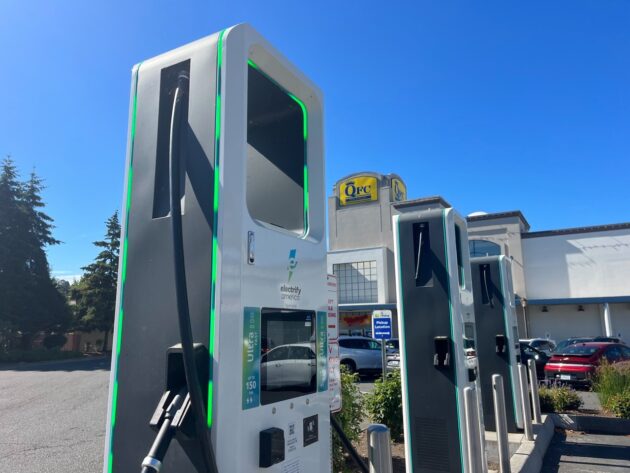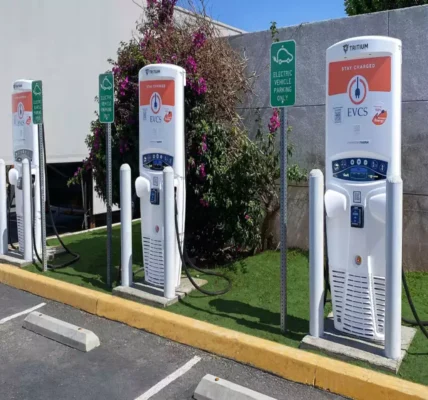Electrical vehicle drivers in Seattle currently looking for a fast charge at a public station are likely to find a frayed stump where the charging cable used to be. In the last 12 months alone, thieves have stolen at least 100 EV charging cables across the city in pursuit of the small amounts of copper within that can be sold as scrap. The thefts are particularly painful for drivers who lack home chargers and are left scrambling to find a way to juice up their vehicles. Each damaged charger can cost thousands of dollars to repair.
“It’s a serious and frustrating problem around Seattle,” said resident Elaine Wong, who relies entirely on public stations to power her EV.
Fast chargers outside grocery stores and other public stopover points have been hit the hardest. The devices can restore battery levels to 80% in 30 minutes, but the thefts have created fast-charging deserts around the city. “Cable theft from public chargers has been an issue in this area for over a decade, but has reached epidemic proportions in the last couple of years,” said Jay Donnaway, president of the Seattle EV Association (SEVA). The problem appears to be much worse on the West Coast than elsewhere, said Donnaway, based on conversations with EV advocates nationwide.
Wong said that in recent months, she hasn’t been to a single Electrify America station in the city where all the charging cables are intact. On the social platform Nextdoor, one respondent this week said she had to drive 30 miles north of Seattle to Everett to find a working station where her son could plug in his car.Charging station provider EVgo agreed that the problem is particularly bad in this region. In an email to GeekWire, the company called Seattle “one of the hotspots nationally for charger vandalism.” EVgo has called for “an all-hands-on-deck approach” to addressing the thefts and is working with other providers, utility companies and city officials.But the problem has so far defied an easy fix.
“Preventing further thefts is difficult,” Officer Eric Muñoz, a spokesperson for the Seattle Police Department, said by email. The department is assigning cable theft reports to its Major Crimes Task Force, Muñoz said, “due to the frequency and high dollar amount, and the likelihood of repeated, targeted crimes.” Detectives are using surveillance footage to try to identify culprits.
The thefts are likely driven in part by the price of the copper in the cables, which is at an all-time high at $5.20 a pound, according to a recent story by the Associated Press. But while the cables are thick, they contain little of the precious metal, yielding no more than $20 worth of copper per cable, the AP reported.
Once a cable is replaced, it becomes a fresh target. “It’s a vicious cycle,” said Wong. “Once they have been fixed, a few days later they are cut again.”
Since July of last year, Electrify America reported 93 cables cut in Washington. The prime target in the state is a charging station behind a Bank of America in Seattle’s Georgetown neighborhood, which thieves have hit nine times, taking a total of 51 of Electrify America’s cables. A site outside a grocery store in Seattle’s University Village reported 22 stolen cables.
Last week, half of the cables at an EVgo station outside the QFC in Ballard were cut overnight, according to a store employee. Customers came in to report the thefts when the store opened in the morning.
Other Western Washington cities are also being hit hard. EV drivers in Tacoma have reported that few functional fast chargers remain in the city, Donnaway said. In rural Sumner, a small city south of Seattle, thieves cut and stole wire from cables at a new charging station before it was even operating. It was vandalized again later the same month.
The pervasive thefts could undermine the state’s efforts to ramp up EV adoption. By 2035, Washington will require all cars and light-duty trucks purchased to be zero-emission. Many people have already made the switch. EVs accounted for 19% of all vehicles purchased in Washington last year — second only to California — according to data collected by the state.
With more and more EVs on the road, finding ways to support drivers with convenient infrastructure is essential. Many owners can’t afford to install charging stations at their homes or live in apartment buildings that may not have access to chargers.
State lawmakers have tried to address the challenge, last year passing a measure that defined EV charging equipment as “commercial metal property,” which requires scrap buyers to track and and report questionable sources of the material. But as Donnaway pointed out, the copper is usually stripped from the cables before it’s sold, making it difficult for a buyer to trace it to EV charging equipment.
Electrify America told GeekWire that it’s increasing the use of cameras and improving the lighting at stations, as well as “exploring other measures” in order to deter criminals. But as long as the price of copper remains high and the cables can be cut to extract it, theft is likely to be a problem. Donnaway believes the ultimate fix involves changing the apparatus itself. He has devised a stainless-steel sheathed cable that is much harder to cut — though in a test of his solution, vandals still managed to damage the cable, making it unusable.
The U.S. Department of Energy is funding a pilot project in which EV drivers carry their own charger cables that plug into outlets. It’s a solution that is proving popular in Europe. In the Eastern Washington city of Wenatchee, the public transit agency uses a wireless, magnetic induction system beneath the pavement that charges buses by simply parking above them.
Meanwhile, charge station providers are trying to keep up with the thefts by replacing the missing cables as soon as possible. “We are doing everything we can to minimize impact to customers in the near term,” said Electrify America, “and are working within the industry toward longer-term solutions.”








